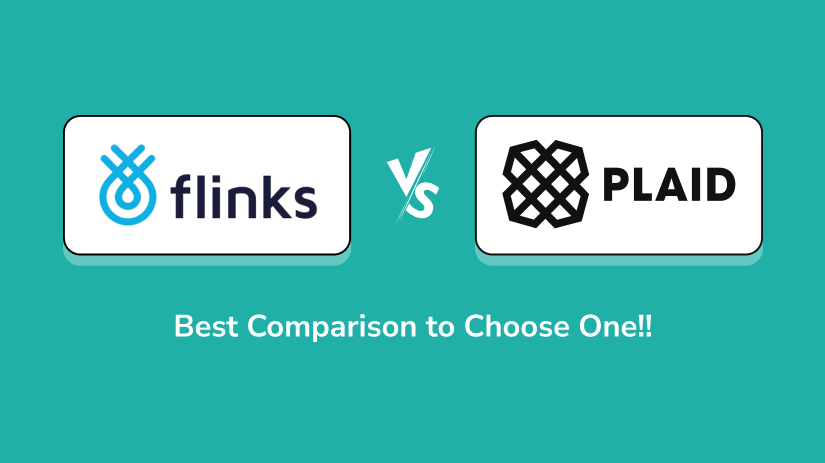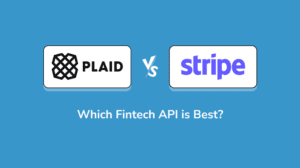Financial data aggregation has become increasingly important in today’s digital age, enabling businesses and individuals to access and analyze their financial information seamlessly.
Two leading players in this field are Flinks and Plaid, each offering unique features and services tailored to different needs.
In this article, we’ll delve into a comprehensive comparison between Flinks and Plaid to help you make an informed decision.
Connect with us for Fintech Development Needs
Trusted by companies like Plaid, Yodlee, Codat.
What is Flinks?

Flinks is a robust financial data aggregator that provides seamless access to financial data from various sources. It offers a wide range of features, including bank account verification, transaction history retrieval, and income verification.
Flinks is known for its user-friendly interface and easy integration options, making it a popular choice among businesses looking to streamline their financial processes.
What is Plaid?

Plaid is a leading financial technology company that specializes in building connections between financial institutions and applications. It offers a suite of APIs that enable developers to access financial data securely and efficiently.
Plaid’s services include bank account authentication, transaction categorization, and identity verification, making it a versatile solution for businesses operating in the fintech space.
Comparison of Flinks and Plaid
Data Coverage and Sources
Flinks API Integration boasts extensive coverage of financial institutions across North America, including banks, credit unions, and investment firms.
Plaid, on the other hand, offers broader coverage with connections to thousands of financial institutions worldwide, making it a preferred choice for businesses operating globally.
Security Measures
Both Flinks and Plaid prioritize security and compliance, implementing robust encryption protocols and strict data protection measures.
However, Plaid has received widespread recognition for its advanced security features, including multi-factor authentication and continuous monitoring, which enhance user trust and confidence.
Pricing Structure
Flinks and Plaid offer competitive pricing models tailored to the needs of businesses of all sizes.
Flinks typically charges based on the volume of API calls or transactions, while Plaid offers tiered pricing plans with additional features and support options for enterprise clients.
User Interface and Experience
Flinks is lauded for its intuitive user interface and seamless user experience, with features designed to streamline financial data access and analysis.
Plaid Integration Services also offers a user-friendly interface but is often praised for its extensive customization options and developer-friendly APIs, allowing for greater flexibility and control.
Customer Support
Both Flinks and Plaid provide dedicated customer support channels, including email, phone, and chat support, to assist users with integration, troubleshooting, and technical queries.
However, Plaid’s larger support team and extensive documentation library give it an edge in terms of responsiveness and resource availability.
Use Cases
Flinks and Plaid are utilized across various industries, including banking software development, lending app development, wealth management, and personal finance.
Businesses leverage these platforms to streamline account onboarding processes, improve risk assessment models, and enhance customer engagement through personalized financial insights and recommendations.
Connect with us for Fintech Development Needs
Trusted by companies like Plaid, Yodlee, Codat.
Pros and Cons

Flinks
Pros
- User-friendly interface
- Seamless integration options
- Competitive pricing
Cons
- Limited international coverage
- Less customization compared to Plaid
Plaid
Pros
- Extensive data coverage
- Advanced security features
- Customizable APIs
Cons
- Higher pricing for enterprise features
- Steeper learning curve for developers
- Decision-making Factors
When choosing between Flinks and Plaid, consider factors such as data coverage, security, pricing, user experience, and integration capabilities.
Assess your specific needs and preferences to determine which platform aligns best with your business objectives and technical requirements.
Connect with us for Fintech Development Needs
Trusted by companies like Plaid, Yodlee, Codat.
Integration and Implementation
Integrating Flinks or Plaid into your existing systems requires careful planning and execution.
Both platforms offer comprehensive documentation and developer resources to facilitate integration, but it’s essential to consider factors such as API compatibility, data migration, and regulatory compliance throughout the implementation process.
Customer Reviews
Feedback from users of Flinks and Plaid highlights the strengths and weaknesses of each platform. While some users praise Flinks for its simplicity and affordability, others prefer Plaid’s robust features and global reach.
Ultimately, customer reviews can provide valuable insights into the real-world performance and reliability of each platform.
Future Developments
As the financial development technology landscape continues to evolve, we can expect Flinks and Plaid to introduce new features and enhancements to meet the evolving needs of businesses and consumers.
Look out for advancements in areas such as machine learning, data analytics, and regulatory compliance to stay ahead of the curve in financial data aggregation.
Conclusion
In conclusion, both Flinks and Plaid offer powerful solutions for financial data aggregation, each with its own strengths and weaknesses.
By carefully evaluating factors such as data coverage, security, pricing, and user experience, you can choose the platform that best fits your specific requirements and objectives.
Whether you’re a small startup or a large enterprise, selecting the right financial data provider is crucial for driving innovation and success in today’s digital economy.
Frequently Asked Questions (FAQs)
1. What are the main differences between Flinks vs Plaid?
Flinks offers extensive coverage in North America with a user-friendly interface, while Plaid provides broader global coverage and customizable APIs.
2. Can Flinks and Plaid be used together?
Yes, businesses can integrate both Flinks and Plaid into their systems to leverage the unique features and data sources of each platform.
3. How secure are the platforms of Flinks and Plaid?
Both Flinks and Plaid prioritize security and compliance, implementing robust encryption protocols and continuous monitoring to protect user data.
4. Are there any hidden fees associated with using Flinks vs Plaid?
Both Flinks and Plaid offer transparent pricing models, with fees based on usage or subscription plans tailored to the needs of businesses.
5. Which industries benefit the most from Flinks or Plaid integration?
Industries such as banking, lending, wealth management, and personal finance benefit significantly from Flinks and Plaid integration, enabling streamlined processes and enhanced customer experiences.





